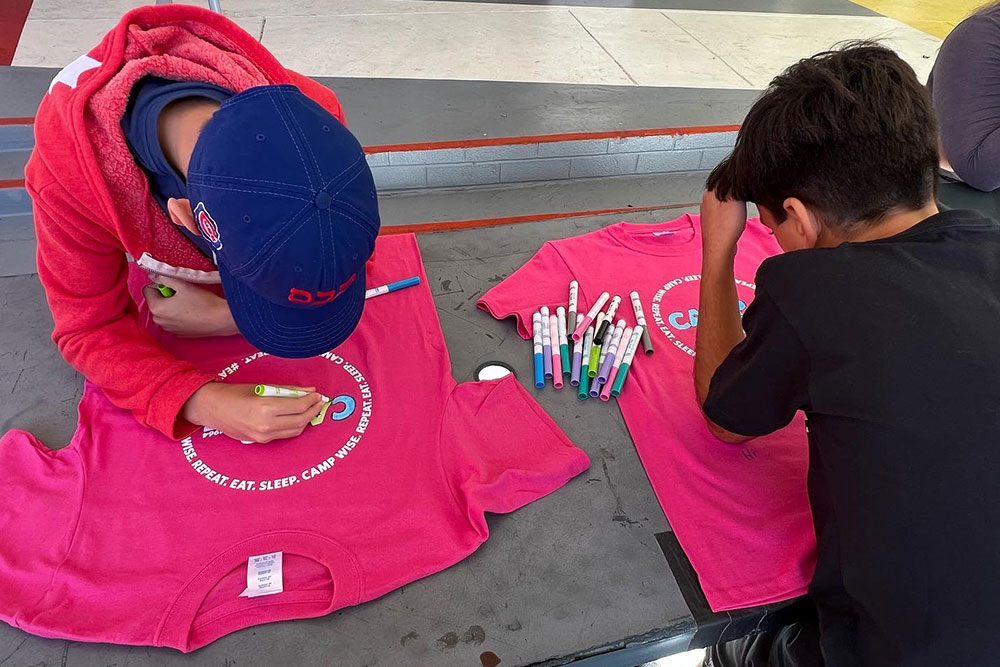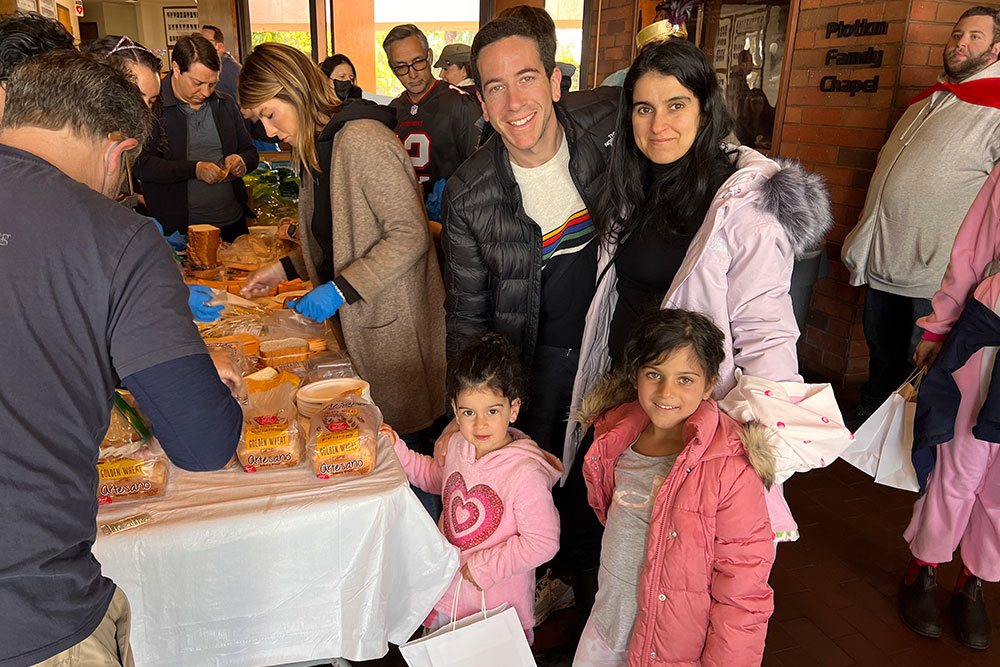Our Philosophy

Our Family Learning Experience programs, including the Tu B’Shvat Sustainability Day, puts children and parents to experience living Judaism.
Through customization, strategic partnership, and a commitment to safety and excellence, Wise offers unsurpassed flexibility in Jewish community and Jewish learning, all while making Jewish learning more accessible and engaging for all. We steadfastly believe that 21st Century Jewish families need and deserve choices that enable them to control the focus, frequency, and format of their children’s Jewish learning.
By offering students in Grades K-6 four options for Judaic studies and two options for prayer studies, unlike the traditional weekly religious school, Wise gives parents unprecedented control over their child’s Jewish education, enabling them to tailor the experience to fit the character and schedule of their child and family. All our offerings may be combined in any fashion that a family desires, making for a fully customizable experience. We also offer options for TK students, so that you can always have a Jewish educational opportunity for your child!
Meanwhile, once they become teens, students receive the choice to determine the most compelling way to continue their Jewish experience. By simply enrolling in Wise Temple Youth, parents give their teens access to youth group, courses, field trips, service opportunities, internships, and more!
Our Curriculum
All our experiences, from TK through Grade 12, are planned and orchestrated with the goals of nurturing the whole child, using the five following strategic objectives to guide their Jewish learning and engagement.
- Question. Navigate life’s challenges and mysteries with critical thinking, curiosity, and wonder.
- Make a difference. Make the world a more just and moral place.
- Be good. Make choices consistent with progressive Jewish values.
- Be fulfilled. Find shalom through a sense of purpose and resilience.
- Connect. Understand the strength of community, history, and heritage – on their own, and as the key to achieving the goals above.
If you want to learn more about our curriculum and how it can help your family meet its goals for Jewish living, please contact us today at [email protected]!

Students engage both body and spirit as they discover the richness of Jewish Values at Camp Wise Sundays.
Why Jewish Education?

Families make lunches to share with Angelinos experiencing food scarcity at our Wise Purim Carnival.
Throughout their history, the Jewish people have engaged in an ongoing search for purpose and meaning that has led to countless developments affecting the ways in which we live and think. Jewish education and Jewish community enable children and adults alike to continue this conversation, augmenting our perspectives with the wisdom and values of our forebears while advancing their search for purpose and meaning. In order to lead deep and engaging Jewish lives, we must embrace deep and engaging Jewish learning and community.
However, Jewish education isn’t just essential to being good Jews! Modern research suggests that Jewish education and participation in a Jewish community makes us healthier, happier, and more successful, too.
- Health: For years, clinical studies have linked a strong religious identity to lower rates of coronary disease,[i] lower blood pressure,[ii] and longer life expectancy.[iii] More recently, researchers investigating a wide array of psychological disorders—such as depression—have generally found religious involvement to be related to better mental health.[iv]
- Happiness: There is also increasing evidence that a strong relationship exists between religious identity and a sense of well-being, including a national study illustrating that adults with strong religious affiliation are nearly twice as likely to report leading “very happy” lives as adults with minimal religious affiliation.[v]
- Success: Longitudinal studies teach that that religious identity is related to increased levels of education,[vi] lower rates of crime,[vii] increased civic involvement,[viii] and higher family satisfaction in adults, as well as higher levels of resilience in children.[ix]
In short, religious education provides a measurable advantage in the pursuit of a meaningful, healthy, happy, and successful life. For our children, that advantage begins here at our Center for Youth Engagement, which offers children and teens the opportunity to develop their Jewish identity through engaging, exciting experiences that speak directly to their questions, their passions, and their dreams.
Contact Rabbi Josh and our CYE team today to answer any questions you may have about how to give your child the gift of Jewish education and Jewish living!
References
[i] Comstock and Partridge 1972.
[ii] Larson et al. 1989.
[iii] George et al. 2002; Hummer et al. 1999; Idler and Kasl 1997; Koenig 1997; Larson et al. 1997; Litwin 2007; Plante and Sherman 2001; Seybold and Hill 2001.
[iv] Hackney and Sanders 2003; Kendler et al. 2003; Larson et al. 1992; Smith et al. 2003.
[v] Myers 2000.
[vi] Gruber, J. 2005.
[vii] Baier and Wright, 2001.
[viii] Putnam 2000; Ruiter and De Graaf 2006.
[ix] Mahoney et al. 2001
Baier, C., & Wright, B. R. E. (2001). ‘‘If you love me, keep my commandments’’: A meta-analysis of the effect of religion on crime. Journal of Research in Crime and Delinquency, 38(1), 3–21.
Comstock, G. W., & Partridge, K. B. (1972). Church attendance and health. Journal of Chronic Diseases, 25, 665–672.
George, L. K., Ellison, C. G., & Larson, D. B. (2002). Explaining the relationship between religious involvements and health. Psychological Inquiry, 13(3), 190–200.
Gruber, J. (2005). Religious market structure, religious participation, and outcomes: Is religion good for you? NBER working paper.
Hackney, C. H., & Sanders, G. S. (2003). Religiosity and mental health: A meta-analysis of recent studies. Journal for the Scientific Study of Religion, 42(1), 43–55.
Hummer, R. A., Rogers, R. G., Nam, C. B., & Ellison, C. G. (1999). Religious involvement and US adult mortality. Demography, 36(2), 273–285.
Idler, E. L., & Kasl, S. V. (1997). Religion among disabled and nondisabled persons II: Attendance at religious services as a predictor of the course of disability. The Journals of Gerontology, 52B(6), S306– S316.
Kendler, K. S., Liu, X.-Q., Gardner, C. O., McCullough, M. E., Larson, D., & Prescott, C. A. (2003). Dimensions of religiosity and their relationship to lifetime psychiatric and substance use disorders. American Journal of Psychiatry, 160(3), 496–503.
Koenig, H. G. (1997). Is religion good for your health? Effects of religion on mental and physical health. New York: Haworth Press.
Larson, D. B., Koenig, H. G., Kaplan, B. H., Greenberg, R. S., Logue, E., & Tyroler, H. A. (1989). The impact of religion on men’s blood pressure. Journal of Religion and Health, 28(4), 265–278.
Larson, D. B., Sherrill, K. A., Lyons, J. S., Craigie, F. C., Thielman, S. B., Greenwold, M. A., et al. (1992). Associations between dimensions of religious commitment and mental health reported in the American Journal of Psychiatry and Archives of General Psychiatry: 1978–1989. The American Journal of Psychiatry, 149(4), 557–559.
Larson, D. B., Swyers, J. P., & McCullough, M. E. (1997). Scientific research on spirituality and health: A consensus report. Rockville, MD: National Institute for Healthcare Research.
Litwin, H. (2007). What really matters in the social network-mortality association? A multivariate examination among older Jewish-Israelis. European Journal of Ageing, 4, 71–82.
Mahoney, A., Pargament, K. I., Tarakeshwar, N., & Swank, A. B. (2001). Religion in the home in the 1980 s and 1990 s: A meta-analytic review and conceptual analysis of links between religion, marriage, and parenting. Journal of Family Psychology, 15(4), 559–596.
Myers, D. G. (2000). The funds, friends, and faith of happy people. American Psychologist, 55(1), 56–67.
Plante, T. G., & Sherman, A. C. (Eds.). (2001). Faith and Health: Psychological Perspectives. New York: Guilford Press.
Putnam, R. (2000). Bowling alone: The collapse and revival of American community. New York: Simon & Schuster.
Ruiter, S., & De Graaf, N. D. (2006). National context, religiosity, and volunteering: Results from 53 countries. American Sociological Review, 71, 191–210.
Seybold, K. S., & Hill, P. C. (2001). The role of religion and spirituality in mental and physical health. Current Directions in Psychological Science, 10(1), 21–24.
Smith, T. B., McCullough, M. E., & Poll, J. (2003). Religiousness and depression: Evidence for a main effect and the moderation influence of stressful life events. Psychological Bulletin, 129(4), 614–636.
